|
|
|
Sort Order |
|
|
|
Items / Page
|
|
|
|
|
|
|
| Srl | Item |
| 1 |
ID:
178933
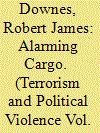

|
|
|
|
|
| Summary/Abstract |
Programme CYCLAMEN was initiated to manage the risk of non-conventional terrorism in the United Kingdom following Al-Qaeda’s attacks against the United States in 2001. Under Programme CYCLAMEN, the UK developed a border monitoring capability to detect and deter the illicit cross-border movement of radiological and nuclear materials by malicious non-state actors. This paper examines the development of border monitoring technologies before and after 9/11 with a focus on Programme CYCLAMEN using two models of state response to terrorism. Under the Control Model, state agencies seek to manage the risk associated with terrorism through disruption of terrorist activities. Under the Regulatory Model, actions are conceptualised as safeguarding public health and safety from various sources of risk including terrorism. The Regulatory Model is found to be dominant before 9/11 but the Control Model dominated thereafter and Programme CYCLAMEN is best understood as emanating from the Control Model. However, earlier action under the Regulatory Model shaped later consideration of this particular border-based protective security measure. This paper explores this shaping process and concludes that the Regulatory Model is under-considered as a model of state response to terrorism.
|
|
|
|
|
|
|
|
|
|
|
|
|
|
|
|
| 2 |
ID:
178914
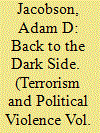

|
|
|
|
|
| Summary/Abstract |
Since the CIA’s inception, elements of the Agency have researched, used, and taught interrogation tactics for national security and counterterrorism purposes. These have sometimes constituted torture, cruel, inhuman, or degrading treatment, and ethical violations. Using the lens of Institutional Change Theory and investigating critical junctures in CIA history, this paper shows that a lack of meaningful internal and external oversight and accountability measures can explain the CIA’s recurrent use and propagation of torture and abuse in interrogation. These findings have implications for future counterterrorism interrogation policy, and preventing the use of ineffective, unethical techniques
|
|
|
|
|
|
|
|
|
|
|
|
|
|
|
|
| 3 |
ID:
178935


|
|
|
|
|
| Summary/Abstract |
Fringe terrorism is common during nonviolent campaigns. We examine how this can modify the strategic environment between dissident groups and the state in ways that present both challenges and opportunities to moderate factions. Terrorism is intended to promote violent escalation in a conflict, but we argue that fringe terrorist activities in a nonviolent campaign under certain conditions can induce an advantage for well-organized moderate factions. The risk of escalation following terrorism can give the government more incentives to offer concessions to moderate campaign leaders if the movement can credibly prevent armed escalation. The ability to control and prevent violence is more likely when nonviolent movements have a hierarchical structure and a centralized leadership, as such campaigns are better able to prevent shifts by supporters towards violent fringes. Using new data on terrorist attacks by factions sharing the same overall objectives as ongoing nonviolent campaigns, we show that nonviolent campaigns are more likely to see substantial gains in spite of fringe terrorist activities when a movement has a hierarchical structure and a centralized leadership.
|
|
|
|
|
|
|
|
|
|
|
|
|
|
|
|
| 4 |
ID:
178936


|
|
|
|
|
| Summary/Abstract |
This article examines the factions, leadership, and internal organization of Boko Haram, the terrorist group which has operated to devastating effect in parts of northern Nigeria, Niger, Chad, and Cameroon. It finds the group’s leadership has been significantly more centralized than previous literature has acknowledged. The leadership was also extremely ruthless but enforced group cohesion by killing anyone who sought to defect. Group members attempted to defect and depose the leadership in 2012 and 2016 by seeking external interventions from Al Qaeda in the Islamic Maghreb (AQIM) and the Islamic State of Iraq and the Levant (ISIL), respectively. In the first instance Boko Haram’s leadership demonstrated control and influence by forcing defectors back into submission, but in the second instance ISIL-backed militants deposed the leadership in a rebellion and coup. The loyalty to ISIL of jihadist commanders and foot soldiers in Nigeria explains why only the rebellion and coup succeeded in 2016 even though AQIM provided greater material support to the first set of defectors in 2012. This article contributes to research on internal dynamics of Boko Haram, the relationships between Al Qaeda and ISIL and their allied and affiliated organizations, and the costs and benefits of extreme leadership for terrorist groups.
|
|
|
|
|
|
|
|
|
|
|
|
|
|
|
|
| 5 |
ID:
178902
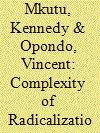

|
|
|
|
|
| Summary/Abstract |
Al-Shabaab, the East-African affiliate of Al Qaeda has carried out a number of large-scale devastating attacks in the region and a steady stream of smaller scale ones. In recent years Al-Shabaab’s ongoing strength has relied upon its ability to build local support within Kenya. This work looks at Kwale County on Kenya’s coast and examines some of the factors involved in radicalization and/or recruitment into the group, including economic hardship, historical marginalization, land injustices, drugs, problems at the family level and poor relationships with state security agencies. It highlights the more recent phenomenon of those returning from fighting with Al-Shabaab and the problems of their reintegration. It concludes that there are a number of phenomenon related in complex and sometimes self-perpetuating ways which all need to be considered in the response to radicalization and recruitment.
|
|
|
|
|
|
|
|
|
|
|
|
|
|
|
|
| 6 |
ID:
178925
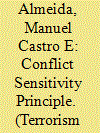

|
|
|
|
|
| Summary/Abstract |
This article explores how best practice in conflict research can address some of the key gaps and limitations of the terrorism research field with regards to research ethics. It draws from conflict research literature, as well as the authors’ primary research experience in Fragile and Conflict-Affected States (FCAS) and in the policy-oriented field of Preventing and Countering Violent Extremism (P/CVE). The analysis focuses on “conflict sensitivity” and the methodological approaches that have been developed and refined under the framework of that principle, including Systems Conflict Analysis. We seek to demonstrate how the integration of research methods related to conflict sensitivity represents an appropriate and fitting research agenda, through which relevant limitations of terrorism research can be addressed. This research agenda emphasizes, among other aspects, the need for solid primary research grounded in a detailed understanding of the local context, a departure from the narrow understanding of the Do No Harm principle in terrorism research, and a greater awareness about the relationship between research ethics and research methods.
|
|
|
|
|
|
|
|
|
|
|
|
|
|
|
|
| 7 |
ID:
178921
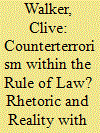

|
|
|
|
|
| Summary/Abstract |
The rule of law remains a hallowed principle even in the unpromising environment of counterterrorism, but failures to live up to rule of law rhetoric must be highlighted. As a result, one might question whether counterterrorism can realistically be conducted wholly in accordance with the rule of law. So, is the rule of law rhetoric or reality? In practice, it remains exceptional for states to resort to express or wide derogations from rule of law standards because of counterterrorism, but notable exceptions in reality undermine the rhetoric of rule of law dominion. By dissecting the rule of law into its constituent components, it is possible to gain a clearer picture of strong and weak points in the rule of law, though no single doctrine, instrument or institution can be found to offer transformational reinforcement. In view of the permanence of counterterrorism, the model required is neither one of accommodation nor an unthinking acceptance of framing ideas such as “the war on terror.” Instead, the rule of law rhetoric demands constant refinement and renewal within the mechanisms of constitutionalism in order to support the reality of rule of law. These precepts will be considered in the context of counterterrorism experiences in the United Kingdom.
|
|
|
|
|
|
|
|
|
|
|
|
|
|
|
|
| 8 |
ID:
178915


|
|
|
|
|
| Summary/Abstract |
This article introduces readers to the Framework for Research Ethics in Terrorism Studies (FRETS). FRETS has been developed to assist IRB/HREC chairs and reviewers in completing reviews of terrorism studies ethics proposals, in as objective a manner as possible. The framework consists of a series of yes/no questions for chairs and reviewers to answer before completing their reviews. These questions are divided into six different sections: participant’s right’s, safety and vulnerability; informed consent; confidentiality and anonymity; researcher’s right’s, safety and vulnerability; data storage and security-sensitive materials; and the ethical review process. This framework was developed as a result of critical analysis of the literature in terrorism research and analogous fields.
|
|
|
|
|
|
|
|
|
|
|
|
|
|
|
|
| 9 |
ID:
178931


|
|
|
|
|
| Summary/Abstract |
This paper contributes to the debate on terrorism designation and proscription by providing information and analysis on the “double-track” system of terrorism designation and proscription in China. It calls for greater attention to China’s terrorism proscription system as China has increased its engagement in international affairs and became more willing and capable of international cooperation in counterterrorism. The case of China provides important insights from a non-Western perspective into how states function in dealing with the challenge terrorism poses. In particular, it examines China’s efforts in balancing effective counterterrorism and the accountability of the government. Adopting an interpretivist approach based on primarily Chinese-language documents, it traces the development of China’s proscription regime since 2003 to illustrate its evolution from ad-hoc list-making to a more complicated system. Because of the difficulties in collecting information and presenting it as admissible evidence in court, like many other countries, China relies on the executive for terrorism designation and proscription. While the workings of China’s proscription system demonstrates authoritarian characteristics, the development of its proscription regime reveals how it sought to respond to the concerns about the legitimacy of its counterterrorism practice, for example, on issues of due process and presumption of innocence.
|
|
|
|
|
|
|
|
|
|
|
|
|
|
|
|
| 10 |
ID:
178934


|
|
|
|
|
| Summary/Abstract |
The performed cross-national tests with negative binomial regression models support the presence of a curvilinear relationship between the quantitative expansion of education (measured with mean years of schooling) and terrorist attack intensity. Growth of schooling in the least educationally developed countries is associated with a significant tendency towards the growth of terrorist attack intensity. This tendency remains significant when controlled for income level, type of political regime, unemployment, inequality, and urbanization; wherein the peak of the terrorist attack intensity is observed for a relatively low, but not zero level of the quantitative expansion of formal education (approximately three to six years of schooling). Further growth of schooling in more developed countries is associated with a significant trend toward the decrease of terrorist attack intensity. This tendency remains significant after being controlled for income level, political regime, unemployment, inequality, and urbanization. The most radical decrease is observed for the interval between seven and eight mean years of schooling. In addition, this quantitative analysis indicates the presence of a similar curvilinear relationship between GDP per capita and terrorist attack intensity with a wide peak from $4000 to $14,000. The explanation of a curvilinear relationship between GDP per capita and terrorist activity through mean years of schooling intermediary can only be partial. The regression analysis suggests that the growth of mean years of schooling with economic development of middle and high income countries may really be one of the factors accounting for the decrease of terrorist attacks in countries with GDP per capita growth. However, this regression analysis indicates that a partial role in the explanation of negative correlation between GDP per capita and terrorist attack intensity for middle and high income countries is also played by a lower level of unemployment rate in the high income countries, as well as by a very high share of consolidated democracies and an extremely low share of factional democracies among the high income states. It is especially worth noting that after the introduction of all controls, the coefficient sign for per capita GDP changes from negative to positive, i.e., GDP growth in middle and high income countries after the introduction of controls for inequality, education, unemployment, type of regime, etc. turns out to be a factor of increase rather than decline of the intensity of terrorist activity. On the one hand, this suggests that the negative correlation between per capita GDP and the level of terrorist activity in these countries is actually explained to an extremely high degree by the fact that per capita GDP growth here tends to be accompanied by an increase in the educational level of the population, a decrease in unemployment, a reduction in inequality, a decrease in the number of factional democracies, and an increase in the number of consolidated democracies. On the other hand, the positive sign (with a statistically significant correlation) indicates here that if in the middle and high countries economic growth is not accompanied by an increase in economic equality and education of the population, a decrease in unemployment, a decrease in the number of unstable factional democracies, and an increase in the number of consolidated democracies (that is, if in fact all the fruits of economic growth are captured by the elites, and almost nothing gets from this growth to the commoner population), then such economic growth would tend to lead to an increase in terrorist activity (and not to its reduction).
|
|
|
|
|
|
|
|
|
|
|
|
|
|
|
|
| 11 |
ID:
178916


|
|
|
|
|
| Summary/Abstract |
This chapter first describes the importance of secret intelligence in protecting the public from terrorist attacks. The use of intelligence in deriving the strategic aim of the integrated U.K. counter-terrorism strategy, CONTEST, and supporting its delivery is examined. The ethical issues associated with the general practice of secret intelligence are identified by referencing the Just War tradition establishing ethical restraints on armed conflict. Parallels are drawn to derive jus ad intelligentiam and jus in intelligentio ethical concepts to govern the acquisition and use of secret intelligence. The chapter concludes by applying these ideas to the techniques currently in use for counter-terrorism, especially the role of digital intelligence gathering today in helping uncover terrorist networks and frustrate attacks. Specific areas of counterterrorism work that nevertheless continue to raise significant ethical issues are identified.
|
|
|
|
|
|
|
|
|
|
|
|
|
|
|
|
| 12 |
ID:
178932


|
|
|
|
|
| Summary/Abstract |
Over the last two decades, there has been a massive increase in research examining terror and extremist-related violence. Few have considered the extent to which these same groups may engage in attacks against digital infrastructure and the Internet, whether through hacking or other methods. The absence of empirical evidence calls to question the nature and dynamics of cyberattacks performed by extremists and ideologically motivated actors. This study attempted to address this gap in the literature through a qualitative investigation of 26 attacks performed by far-left groups against targets in the UK, US, and Canada from 2000 to 2015. This data was compared to physical attacks documented in the Extremist Crime Database during the same period. The findings demonstrated that there was an increase in cyberattacks during a period of decreased physical violence by far-left groups. Additionally, there was some parity in the targets of far-left groups on- and off-line, with similar motivations to cause harm to or embarrass businesses, government organizations, and individuals. The implications of this study for our understanding of terror and future research were discussed in detail.
|
|
|
|
|
|
|
|
|
|
|
|
|
|
|
|
| 13 |
ID:
178917


|
|
|
|
|
| Summary/Abstract |
A robust empirical finding is that global neojihadi terrorism is extremely rare in Western countries compared to other kinds of violence. Its base rate in the West is about 3 new global neojihadis per 100 million people per year. Bayesian conditional probability shows that this extremely low base rate ensures that any attempt to detect a potential global neojihadi on the basis of imperfectly specific indicators (conditions) will generate a large number of false positives. This finding has practical implications for a preventive counterterrorism strategy based on detection of potential global neojihadi terrorists using these indicators derived from counterterrorism research. Detection instruments based on them produce many false positives, namely overt sympathizers, who, absent state agents’ entrapment, never cross the line to political crime and violence. The state pursuit of false positives not only diverts scarce resources from targeting true threats but also results in unfair harassment, persecution, and even prosecution of these false positives. This paper suggests that, as scholars whose work helps craft these indicators, we have the moral duty to teach state practitioners about this relatively neglected implication of the extremely low base rate of global neojihadi terrorism.
|
|
|
|
|
|
|
|
|
|
|
|
|
|
|
|
| 14 |
ID:
178900
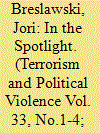

|
|
|
|
|
| Summary/Abstract |
Why do some militant groups use rhetoric that indicates intentions of democratic governance, while others are silent on these issues, or even clearly oppose them? In this article, I explore militant groups’ desire for external legitimacy, and seek to explain when they are willing to make costly promises to follow liberal norms. I argue that human rights media attention has a significant effect on group behavior. Specifically, militant groups are more likely to use democratic rhetoric when they are “in the spotlight,” which results in a higher likelihood of external legitimacy in exchange for following costly liberal norms. Using the Minorities at Risk Organizational Behavior (MAROB) data for the Middle East, Eastern Europe, and Russia, as well as a historical analysis of three militant groups in Indonesia, I find that militant groups residing in areas that receive a large amount of media attention are more likely to support democratic practices.
|
|
|
|
|
|
|
|
|
|
|
|
|
|
|
|
| 15 |
ID:
178943
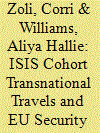

|
|
|
|
|
| Summary/Abstract |
We explore the underappreciated role of organizational tactics in terrorist violence in an understudied single case: ISIS’s execution of the November 13, 2015 Paris attacks. It is one of the first systemic reconstructions of the journeys made by two ISIS strike cohorts in the coordinated attacks, as teams traveled from the Levant to Europe. In contrast to other high-profile attacks, terrorism scholars have not undertaken a detailed reconstruction of this event, even while open source information is now available. By examining the transnational travels of foreign terrorist fighters, we identify ISIS’s distinctive terrorist outsourcing strategy in which operatives used their experiences to adapt to changing security conditions, while EU governments revealed limited responses. Both elements in this tightly-knit dynamic—terrorist outsourcing savvy using FTFs and EU security policy failures—were necessary to achieve this high-profile attack. The essay contributes to descriptive empirical and theoretical knowledge of terrorist tactical innovation and adaptive operational learning, as these capacities are enhanced by on-the-ground organized networks to increase organizational (versus lone-wolf) campaign success. By using a single case interdisciplinary and exploratory framework, terrorism studies can delve deeper into superficially understood phenomena to isolate concepts with future cross-case value, such as cohorts and tactical adaptation.
|
|
|
|
|
|
|
|
|
|
|
|
|
|
|
|
| 16 |
ID:
178940


|
|
|
|
|
| Summary/Abstract |
This article contributes to the growing literature on dark networks through an analysis on the Australian neojihadist network (ANN). Through analysis of Australian terrorist cells, we present a visualisation of the cells’ structures to determine how individuals are connected within each cell and to the wider ANN. A detailed analysis of six separate cells was undertaken to determine the operations, structures, and interactions of individuals within each cell. A visual network is presented to demonstrate how six cells that span a 14-year period form an interconnected network of individuals linked by family and close friendships. The insights gained through the analysis of this dark network sheds light on the origins, evolution, and structure of the ANN and highlight the way in which Australia’s experience with home-grown terrorism has evolved into an interlinked overarching illegal network that transcends both geographical locations and individual operations.
|
|
|
|
|
|
|
|
|
|
|
|
|
|
|
|
| 17 |
ID:
178904


|
|
|
|
|
| Summary/Abstract |
This paper reports on a study that is part of a project which aims to develop a multimodal analytical approach for big data analytics, initially in the context of violent extremism. The findings reported here tested the application of natural language processing models to the text of a sample of articles from the online magazines Dabiq and Rumiyah, produced by the Islamic extremist organisation ISIS. For comparison, text of articles found by reverse image search software which re-used the lead images from the original articles in text which either reported on or opposed extremist activities was also analysed. The aim was to explore what insights the natural language processing models could provide to distinguish between texts produced as propaganda to incite violent extremism and texts which either reported on or opposed violent extremism. The results showed that some valuable insights can be gained from such an approach and that these results could be improved through integrating automated analyses with a theoretical approach with analysed language and images in their immediate and social contexts. Such an approach will inform the interpretation of results and will be used in training software so that stronger results can be achieved in the future.
|
|
|
|
|
|
|
|
|
|
|
|
|
|
|
|
| 18 |
ID:
178937
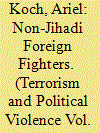

|
|
|
|
|
| Summary/Abstract |
The ongoing war in Syria reflects the interesting phenomenon of foreigners flocking to the troubled region to join the combat. While foreign Jihadists joining the fighting ranks of terror organizations such as the Islamic State or Al Qaeda have attracted considerable reporting and research, the flip side of this phenomenon has gone largely unnoticed—that of the foreign anti-ISIS fighters. Although these fighters share a common enemy, adversary on the battlefield, they hold disparate personal ideologies and motives. This article will examine manifestations of foreign anti-ISIS fighters affiliated with both the far right and far left ideologies, in order to contribute to the understanding of this unfamiliar aspect of the war in Syria and its scope, as well as the potential consequences and potential threats it embodies.
|
|
|
|
|
|
|
|
|
|
|
|
|
|
|
|
| 19 |
ID:
178945


|
|
|
|
|
| Summary/Abstract |
Altier, Boyle, and Horgan claim a 64.6 percent terrorist recidivism rate. However, the unrepresentativeness of their sample, a confusion between the notions of a recidivism base rate and the percentage of recidivists in a sample, and a questionable concept of a global terrorist population undermine their claim.
|
|
|
|
|
|
|
|
|
|
|
|
|
|
|
|
| 20 |
ID:
178946


|
|
|
|
|
| Summary/Abstract |
We thank Marc Sageman for his interest in our article and are grateful to Terrorism and Political Violence for the opportunity to respond. Our study was part of a three-year grant-funded project entitled “Pathways, Processes, Factors, and Roles for Terrorist, Disengagement, Re-engagement, and Recidivism.” The aim was to better understand individual-level disengagement from terrorism, as well as re-engagement and recidivism. We conducted two extensive reviews of literature from relevant disciplines—one on terrorist disengagement and another on terrorist re-engagement and recidivism.1 We then collected and analyzed data from a sample of autobiographies penned by individuals formerly involved in terrorist groups and conducted in-depth, in-person interviews with another sample of individuals who had left terrorist groups. The questionnaire and codebook that we developed to capture information from our autobiographical sample compiled data on subjects’ lives prior to their involvement in terrorism, important aspects of their involvement in terrorism including the nature of the groups they belonged to, and the conditions surrounding their disengagement and re-engagement and/or recidivism. An entire section of our questionnaire and codebook are dedicated to investigating not only whether individuals re-engaged, but the circumstances of that re-engagement and what we identified as hypothesized risk factors. We reiterate this because Sageman implies throughout his critique that we were using data that we originally compiled to study something else (disengagement) to then “derive a recidivism rate.” We did not. Although our findings on disengagement were analyzed and published first,2 the purpose of the broader project was always to consider re-engagement and recidivism. This informed our review of relevant literature, generation of hypotheses, and the development of data collection protocols.
|
|
|
|
|
|
|
|
|
|
|
|
|
|
|
|
|
|
|
|
|